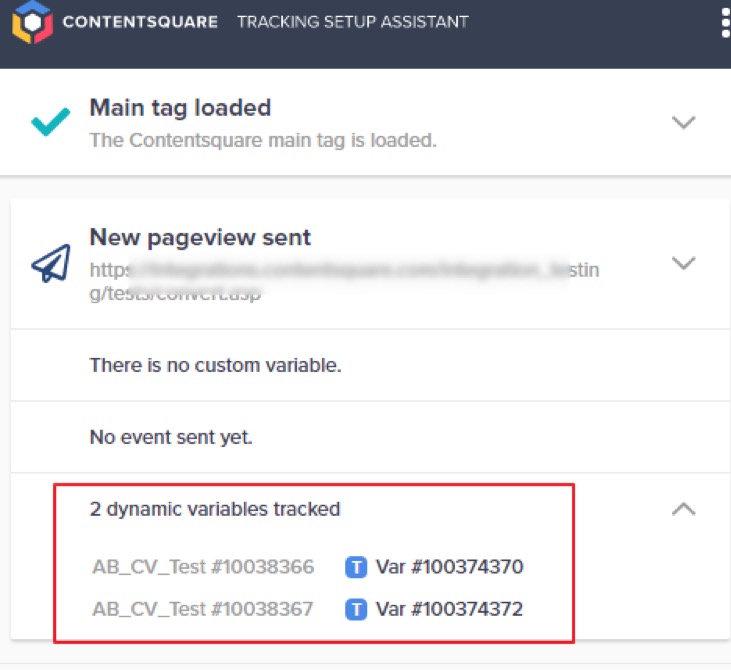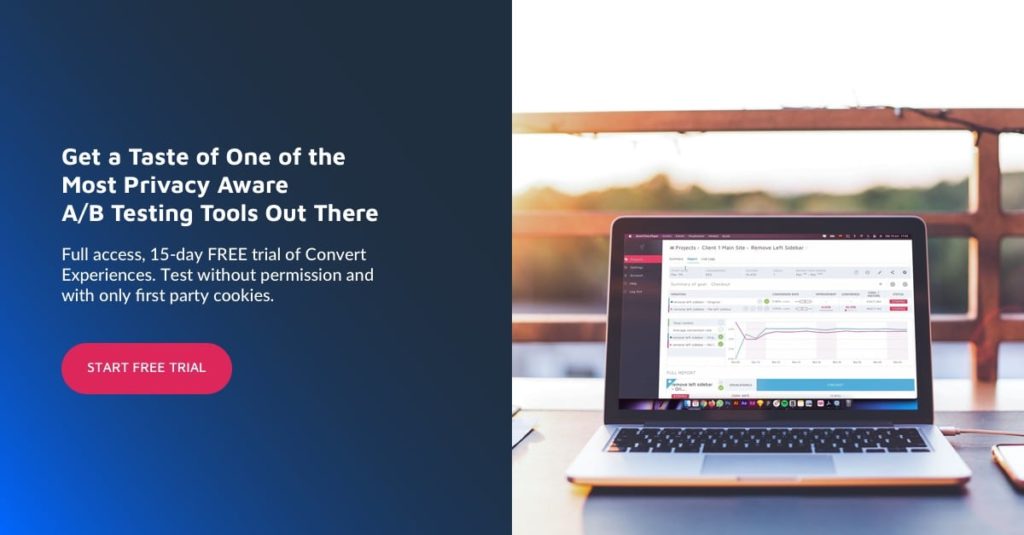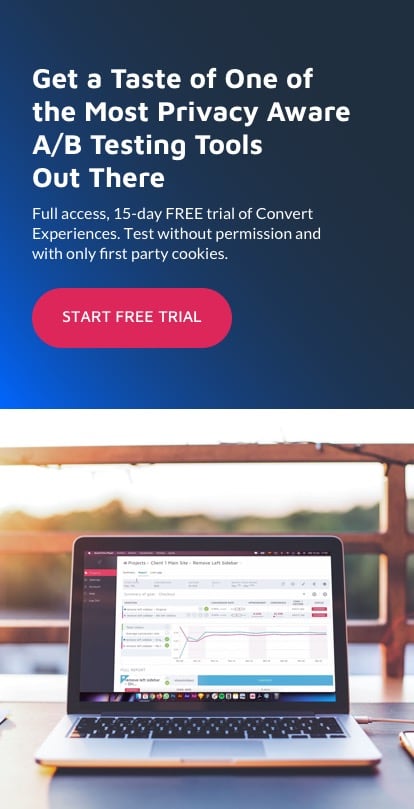Contentsquare + Convert: New Behavioral Insights Into Your A/B Experiences

Contentsquare is an enterprise-level UX optimization platform. Acting as a prioritization layer between traditional analytics tools and Convert, Contentsquare empowers the entire digital team to identify areas of focus for testing, enabling you to run more accurate tests and create uplift more often.
Visualize how your audience navigates your site using Contentsquare’s ‘customer journey analysis’ module. Use the ‘zone-based heatmaps’ module to attribute revenue and other UX metrics to individual in-page content elements, see which parts of your page are driving conversions, and which need attention. Use the Session Recreation module, according to specific segments or visitor struggles, to dig even deeper into what is driving certain behaviors and let the AI bot automatically recommend MVT winning variations based on metrics you define.
All this is possible using the Contentsquare + Convert integration, which takes minutes to install so you can start collecting data right away.
Integrate Convert Experiences with Contentsquare
Integrating Contentsquare with Convert Experiences makes it easy to explore and compare the different ways users experience your website test variants. The Contentsquare + Convert workflow is ideal for showcasing how well users can reach their objectives and drawing better conclusions about tests.
Here’s how it works:
- Contentsquare automatically detects the Convert experiments on your site.
- You can filter your Contentsquare experiments by Convert experiment ID and its variants.
- Your session recreation list will be curated to show you user sessions experiencing your test variants.
Set up the Integration:
To integrate the two platforms:
- Add the Convert Experiences Tracking Code to your website.
- Add the Contentsquare Main Tag to your website.
- Enable the Contentsquare – Convert integration by adding a tag in your Tag Management System with code.
For more details, read the full step-by-step instructions here.
Verify the Integration:
Once the installation is ready, verify the setup by installing the Convert Chrome Debugger and also check which variables are being sent to Contentsquare.

What Data is Being Used?
After the integration is enabled, every session in your Contentsquare account will be tagged using this format: “AB_CV_Test#xxxxxxx – Varxxxxxxx”, where:
- AB_CV_ is the variable dynamic prefix;
- Test#xxxxxxx – the name of the experiment or the Experiment ID as found in your Convert account, depending on whether you have data anonymization enabled or not;
- Varxxxxxxx – the name of the variation or the Variation ID as found in your Convert account, depending on whether you have data anonymization enabled or not;
Inside your Contentsquare account, you can filter the events based on a certain Experiment – Variation pair to analyze visitor behavior when served a particular variation.
What’s Next?
Once you have Convert with Contentsquare up and running, what next?
Now we’ll show you how even basic use of Convert Experiences can help you improve your landing pages, form fields, CTAs, responsive design, and much more. You can see:
- How many visitors your website gets,
- How long your visitors hang around,
- Which devices (mobile, desktop, tablet) your visitors use,
- If your product image is actually appealing,
- If the store inspires an action from the visitor,
- If the product’s positioning on the page is awkward for the customer,
- If they have to scroll down too far to get to the product.
The amount of information you can get can feel overwhelming and we recommend not diving in too deep at first. Focus on the key metrics that really matter to you.
Combine Customer Journey Analysis with A/B Testing
Whilst A/B testing can be highly effective, it is not always enough to get a true idea of what your customers need or want. You should blend a range of techniques to build the best possible picture of how your users use your site. Together with A/B and multivariate tests, Customer Journey Analysis is the new kid on the conversion rate optimization (CRO) block. The power of customer journey analysis is that it looks beyond an individual landing page, headline, or call-to-action. Instead, it takes into consideration the entire conversion path — from a website visit to purchase.
Thus, on pages where you run Convert experiments, you can use Contentsquare’s Customer Journey Analysis module to identify areas of improvement based on analyses of the entire customer experience – keyword search behavior, email copy, form design, checkout funnel – focusing on pain points and supporting promotional initiatives.
Use Struggle Analysis for a Frictionless Customer Experience
In today’s fast-paced world of on-demand services, entertainment, and products, customers have high expectations. Consumers now expect to have not only a good experience, but one that is based on their preferences. This is no easy feat for businesses, no matter how large or small they are. There’s a lot that goes into creating a great customer experience, one that satisfies all customers and has them coming back to your business. One key element of a great customer experience is less friction in the customer journey. Customers don’t want to deal with businesses that make them jump through hoops and build unnecessary complexity into their buying process.
With Struggle Analysis you can see how visitors navigate page by page on each Convert Variation they are bucketed into, from entry to exit, and fix these friction points in your customer touchpoints.
Customer touchpoints are simply all instances when a brand interacts with customers throughout the purchasing and/or signup process. Take a look at the examples below to get a feel for what counts as a touchpoint:
- Contact forms on your website,
- Newsletter subscription button or bar,
- Free product demo,
- Client testimonials,
- Live Chat,
- Customer service agents and call centers,
- The Comments section on your website or social media posts,
- Your social media profiles,
- Blog posts on your website, or other online platforms,
- Surveys,
- The Contact page,
- Marketing emails.
Struggle Analysis can give you a lot of raw information. In order to use this analysis to reduce friction points, here are some things you should look for:
- How many steps there are in the buying process.
- How long a customer has to wait for a response (in the case of chatbots, live chat, and customer service agents).
- Whether your brand is consistent across all touchpoints.
- How easy it is to get to that touchpoint. For example, is your Contact page prominently displayed on your website so it’s easy to find? Once on the page, do customers have all the information they need on that page, or do they have to click multiple links to get to specific contact details?
- If your marketing emails have a Call-To-Action, is it easy for customers to take action? For example, if you’re offering a deal on specific items, do you link to a page with all of these items listed? Or does the customer have to further navigate your website to find it themselves?
- Do you include a Signature in your emails so your customers know who the message is from and who they should contact if they have any comments or complaints about the content of the emails?
These are good questions to ask when viewing and analyzing Struggle Analytics. They’ll help you prevent friction points where possible.
Make a Device Test with Zone-Based Heatmaps
Your site pages look very different across devices and screens of different sizes.
With the rise in popularity of extra-large screens, netbooks, tablets, and phones, ensuring an optimal experience across gadgets is a challenge.
Important content that is above the fold on a desktop could end up well below the fold on a phone. Equally, your page content could look sparse and unreadable on very large screens.
Zone-based Contentsquare heatmap reports will easily reveal these differences across browsers and devices and how visitors interact with your content. Contentsquare captures 100% of users’ data by default, giving you large data sets to filter through and learn from. Introduce a responsive design so you can adjust your pages to accommodate different screen and browser specs. Use your findings from Zone-based Heatmaps to tweak this responsive design.
Higher engagement and prioritization of key content suddenly becomes possible, even if numerous variables are defining your on-page experience.
Follow up on your changes with new heatmap reports to see the impact of your tweaks.
Once you are done, hand these findings over to Convert personalizations where different audiences will be shown different designs based on their device and browser preferences.
Better Understand Your Sales with Merchandising Analysis
Merchandising Analysis provides a unique technology solution allowing retailers of all sizes to optimize their pricing strategy by monitoring their competitors’ product prices and implementing optimal price strategy adjustments in a highly competitive retail environment.
By adding merchandising analysis — including product, inventory, delivery, reviews, pricing, and promotions data — to your A/B Experiences, you will be able to predict which online shoppers are more likely to buy and how to tailor the experience to improve conversion and customer satisfaction.
Simply run your Convert A/B experience, send the data to your Contentsquare account and combine it with extra KPIs to understand which products to promote on your website and how to optimize online sales performance, by combining customer journey insights, granular data on your product catalog, and your competitors’ pricing.
Once the above analysis is complete, turn the winning variation into a personalization and leave it running for your website visitors by taking advantage of the seamless feature.
Use AI Insights to Run MVT Experiences
With Convert, you can set up multivariate tests (MVT), e.g. with 2 headlines and 2 different images. In this scenario, Convert then creates all possible combinations: headline 1 with image 1, headline 2 with image 2, headline 1 with image 2, and headline 2 with image 1. The outcome of such a test is calculated on the basis of ‘frequentist statistics’. As a result, you need a whole lot of traffic to complete such an MVT within an acceptable period because you can make many different combinations. Each combination is in fact a new version. And because each version needs sufficient traffic and conversions, an MVT has to run for a very long time before you can draw any useful conclusions.
With the Contensquare + Convert integration, you don’t have to jump through that hoop. Contentsquare features an AI-based expert system and a bot named Arti that are intended to boost productivity and revenue by surfacing issues and solutions faster. The analyzed data includes mouse movements and other user interactions.
Now, instead of running and analyzing MVT tests manually, Contentsquare’s intelligence offers personalized notifications with alerts on key performance indicators (KPIs), tailored recommendations for improvements, and a discovery section that presents alerts/improvements in new areas.
Any Privacy Concerns Regarding the GDPR/CCPA?
Both Contentsquare and Convert.com have a privacy-first philosophy that informs everything we do. We both believe that commitment to customers and users extends beyond just providing best-in-class tools to measure and improve user experiences; it also means taking a proactive approach to ensuring the privacy of user data.
With Privacy Laws in place (such as the GDPR/CCPA), recreating user sessions and analyzing customer journeys become a little creepy.
Can this be considered a breach of privacy?
No, because Contentsquare does not collect personally identifiable information (PII) about individual users. Contentsquare provides various tools to enable its customers to block information from being collected through the Contentsquare service. Contentsquare also implements, by default, certain safeguards to ensure certain data is not collected. By way of example, by default, Contentsquare does not collect the value of any keystrokes typed by a visitor on a website. Furthermore, Contentsquare will block all other information that you identify as personal information using Contentsquare’s tools.
Convert truly cares about your privacy and the privacy of your traffic. Conversion rate optimization is essential if you wish to guide your visitors to the best solution you offer, but it can be done ethically and without frustrating users in the process.
This is why we have built a deep integration with a tool like Contentsquare which draws a CRO picture worth a million clicks – without infringing on user rights.



